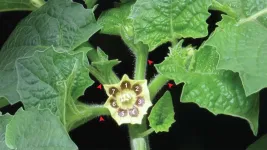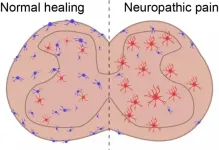(Press-News.org) New collaborative research from Northwestern University and Lund University may have people heading to their backyard instead of the store at the outset of this year's mosquito season.
Often used as an additive for cat toys and treats due to its euphoric and hallucinogenic effects on cats, catnip has also long been known for its powerful repellent action on insects, mosquitoes in particular. Recent research shows catnip compounds to be at least as effective as synthetic insect repellents such as DEET.
But until now, the mechanism that triggered insects' aversion to this common member of the mint family was unknown. In a paper to be published March 4 in the journal Current Biology, a team of researchers from Northwestern and Lund universities report finding the underlying receptors that contribute to the mosquitoes' aversive reaction.
"Catnip and its active ingredient, Nepetalactone, have been used for millennia to ward off insect pests, at least since the time of Pliny the Elder," said Marcus C. Stensmyr, associate professor at Lund University and co-corresponding author. "But why Catnip is so potent on such a broad range of insect species has remained unknown."
Traditional approaches to mosquito control involved insecticides, but those eliminate other insect species as collateral damage. Modern formulations of insect repellents such as DEET target mosquito odor and taste receptors, rendering the insect incapable of recognizing the chemical cues that signal a human prey.
"We discovered that Catnip and its active ingredient Nepetalactone activate the irritant receptor TRPA1, an ancient pain receptor found in animals as diverse as flatworms, fruit flies and humans," said Marco Gallio, an associate professor of neurobiology in the Weinberg College of Arts and Sciences. "We now think Catnip is so aversive to so many insect species because it activates this widespread irritant receptor."
In previous work, the Gallio Lab and others demonstrated that humans, insects and many other animal species possess a version of the transient receptor potential ankyrin 1 (TRPA1) ion channel, a protein best known as the "wasabi receptor" that senses environmental irritants like pain and itch.
"What is particularly interesting is that, unlike wasabi or garlic compounds that also activate these receptors in humans, catnip appears to selectively activate the insect receptor," Gallio said. "This explains why humans are indifferent to it, and provides a serious advantage for its use as a repellent."
Why cats are so attracted to catnip is an entirely different story and one that is not entirely understood. Research indicates this may be due to an unusual interaction between one of catnip's active ingredients and a molecular component present in the reward system of the cat brain.
"Mosquitos, in particular those that act as vector for disease, are becoming a bigger problem as climate change creates attractive conditions for them farther north and south of the equator," Stensmyr said. "Plant-derived compounds represent a new emerging approach to developing insect repellents, as plants have long known how to protect themselves from insect pests."
Gallio added that plant-derived repellants are often available at a much lower cost and are easier to obtain. Catnip's accessibility could have major implications in developing countries where mosquito-borne diseases are a huge problem.
The Gallio lab at Northwestern studies the sensory systems of the common Lab fruit fly Drosophila, including the mechanisms that control the responses to external temperature and pain. Lund's Stensmyr lab mainly focuses on mosquitoes and other insect vectors of human disease.
The researchers studied various insect species to better understand how catnip and its active ingredient are working to repel a broad range of insects, while having no irritant effect on humans.
To confirm their results, the team ran a range of tests, including offering mosquitoes a blood meal in a dish covered with a nylon sock doused in catnip, experiments involving a wind tunnel, as well as experiments in which volunteers place their hand in a cage with live mosquitos, with or without the protection of a catnip oil rub.
Gallio believes that the mechanism they discovered also provides proof of concept for the development of next-generation repellents that exploit the same logic - selectively targeting the mosquito irritant receptor.
"This is an entry point to study how this molecule works on the receptor," he said. "Once we understand its chemistry and how it interacts with the receptor, we could design even more powerful and selectively targeted molecules."
The team's next project? Finding out how to get rid of the cats that keep chasing them down.
INFORMATION:
Work in the Gallio lab at Northwestern is supported by NIH grant R01NS086859, R21EY031849, a Pew Scholars Program in the Biomedical Sciences and a McKnight Technological Innovations in Neuroscience Awards to Marco Gallio.
The paper is titled "The irritant receptor TRPA1 mediates the mosquito repellent effect of catnip."
In addition to Gallio and Stensmyr, other authors of the paper are Nadia Melo (first author) and Ayse Yilmaz-Heusinger of Lund; Matthew Capek, Oscar Arenas, Peter Laminette and Alessia Para of Northwestern; and Ali Afifi and Christopher Potter of Johns Hopkins University School of Medicine.
Existing gene drive technologies could be combined to help control the invasive grey squirrel population in the UK with little risk to other populations, according to a modelling study published in Scientific Reports.
Gene drives introduce genes into a population that have been changed to induce infertility in females, allowing for the control of population size. However, they face technical challenges, such as controlling the spread of altered genes as gene drive individuals mate with wild individuals, and the development of genetic resistance, which may render the gene drive ineffective.
To address these challenges, Nicky Faber and colleagues used computer modelling to investigate the effectiveness of a combination of three gene ...
Using theoretical models of bacterial metabolism and reproduction, scientists can predict the type of resistance that bacteria will develop when they are exposed to antibiotics. This has now been shown by an Uppsala University research team, in collaboration with colleagues in Cologne, Germany. The study is published in the journal Nature Ecology and Evolution.
In medical and pharmaceutical research, there is keen interest in finding the answer to how fast, and through which mechanisms, bacteria develop antibiotic resistance. Another goal is to understand how this resistance, in turn, affects bacterial growth and pathogenicity.
"This kind of knowledge would enable better tracking and slowing ...
Induced pluripotent stem cells (iPSC) are suitable for discovering the genes that underly complex and also rare genetic diseases. Scientists from the German Cancer Research Center (DKFZ) and the European Molecular Biology Laboratory (EMBL), together with international partners, have studied genotype-phenotype relationships in iPSCs using data from approximately one thousand donors.
Tens of thousands of tiny genetic variations (SNPs, single nucleotide polymorphisms) have been identified in the human genome that are associated with specific diseases. Many of these genetic variants are ...
A team of scientists from the University of Cologne (Germany) and the University of Uppsala (Sweden) has created a model that can describe and predict the evolution of antibiotic resistance in bacteria. Resistance to antibiotics evolves through a variety of mechanisms. A central and still unresolved question is how resistance evolution affects cell growth at different drug concentrations. The new model predicts growth rates and resistance levels of common resistant bacterial mutants at different drug doses. These predictions are confirmed by empirical growth inhibition curves and genomic data from Escherichia coli populations. ...
Over evolutionary time scales, a single gene may acquire different roles in diverging species. However, revealing the multiple hidden roles of a gene was not possible before genome editing came along. Cold Spring Harbor Laboratory (CSHL) Professor and HHMI Investigator Zach Lippman and CSHL postdoctoral fellow Anat Hendelman collaborated with Idan Efroni, HHMI International Investigator at Hebrew University Faculty of Agriculture in Israel, to uncover this mystery. They dissected the activity of a developmental gene, WOX9, in different plants and at different moments in development. Using genome editing, they found that without changing the protein produced by the gene, they ...
CHAPEL HILL, NC - One of the hallmarks of chronic pain is inflammation, and scientists at the UNC School of Medicine have discovered that anti-inflammatory cells called MRC1+ macrophages are dysfunctional in an animal model of neuropathic pain. Returning these cells to their normal state could offer a route to treating debilitating pain caused by nerve damage or a malfunctioning nervous system.
The researchers, who published their work in Neuron, found that stimulating the expression of an anti-inflammatory protein called CD163 reduced signs of neuroinflammation in the spinal cord of mice with neuropathic pain.
"Macrophages are a type of immune cell that are found in the blood and in tissues ...
What The Study Did: In this study of return-to-play cardiac testing performed on 789 professional athletes with COVID-19 infection, imaging evidence of inflammatory heart disease that resulted in restriction from play was identified in five athletes (0.6%). No adverse cardiac events occurred in the athletes who underwent cardiac screening and resumed professional sports participation.
Authors: David J. Engel, M.D., of Columbia University Irving Medical Center in New York, is the corresponding author.
To access the embargoed study: Visit our For The Media website at this link https://media.jamanetwork.com/
(doi:10.1001/jamacardio.2021.0565)
Editor's Note: The article includes conflict of ...
What The Study Did: Using reverse transcription-polymerase chain reaction testing, this study found that SARS-CoV-2 was present on the ocular surface in 52 of 91 patients with COVID-19 (57.1%). The virus may also be detected on ocular surfaces in patients with COVID-19 when the nasopharyngeal swab is negative.
Authors: Claudio Azzolini, M.D., of the University of Insubria in Varese, Italy, is the corresponding author.
To access the embargoed study: Visit our For The Media website at this link https://media.jamanetwork.com/
(doi:10.1001/jamaophthalmol.2020.5464)
Editor's ...
What The Study Did: This study of more than 526,000 procedures across 17 institutions reports a significant decrease in the use of lasers and cryotherapy, retinal detachment repairs and other vitrectomies, beginning mid-March last year and lasting at least until May.
Authors: Mark P. Breazzano, M.D., of the Wilmer Eye Institute at Johns Hopkins Hospital in Baltimore, is the corresponding author.
To access the embargoed study: Visit our For The Media website at this link https://media.jamanetwork.com/
(doi:10.1001/jamaophthalmol.2021.0036)
Editor's Note: The article includes conflict of interest and funding/support disclosures. ...
What The Study Did: Clinical trial registrations for COVID-19 interventions that were highly publicized during the COVID-19 pandemic compared with treatments not comparably promoted were assessed in this study.
Authors: Nadir Yehya, M.D., M.S.C.E., of the Children's Hospital of Philadelphia, is the author.
To access the embargoed study: Visit our For The Media website at this link https://media.jamanetwork.com/
(doi:10.1001/jamanetworkopen.2021.0689)
Editor's Note: The article includes conflicts of interest and funding/support disclosures. ...


